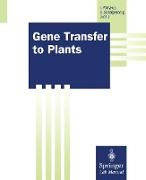Gene Transfer to Plants
BücherAngebote / Angebote:
Gene Transfer to Plants Within a decade of the first recoveries of transgenic "model" plants, gene trans fer is an established and routine technique in numerous laboratories around the world. It contributes to the rapid progress in basic and applied plant sciences in disciplines as diverse as biochemistry, physiology, developmental biology, breeding, food sciences, and biotechnology (Lindsey 1992, Willmitzer and Topfer 1992, Kishore and Somerville 1993, Nessler 1994). Following years of unsuccessful experiments with variations in feeding iso lated DNA to plant tissues and organs, gene transfer became a reality soon after it was discovered that the soil bacterium Agrobacterium tumefaciens contained a plasmid, part of it being transferred to competent plant cells (see Hooykaas, Introduction I: Agrobacterium tumefaciens, a natural vector system). Host range limitations of Agrobacterium-mediated gene transfer prompted the search for alternative gene transfer systems, leading soon to the development of "direct gene transfer to protoplasts" (see Potrykus, Introduction III: Direct gene trans fer to protoplasts). Further limitations in both gene transfer systems led to the exploration of a great variety of further approaches such as pollen transforma tion, pollen tube pathway, electrophoresis, microlaser, liposome-fusion and -injection, macroinjection, direct DNA application in numerous variations, etc. None of these approaches has, so far, been developed to a reproducible gene transfer technique and it is questionable whether they ever led to transformation (for a detailed assessment see Potrykus 1990).
Folgt in ca. 5 Arbeitstagen




